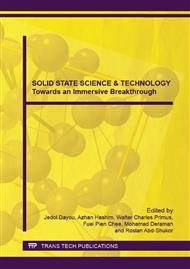p.672
p.678
p.687
p.693
p.699
p.706
p.712
p.716
p.722
Modular Surface Plasmon Resonance (SPR) Biosensor Based on Wavelength Modulation
Abstract:
This paper deals with a new invention of modular surface plasmon resonance (SPR) biosensor device based on wavelength modulation wherein the angle of incidence of the light source is fixed and the shift in wavelength at resonance is monitored. This device is capable of detecting biomolecular binding interactions of different species such as protein and viruses based on changes in the refractive index of the dielectric environment. White light source mounted with a polarizer is used to excite plasmons on the sensor surface which is thin gold film of ~21 μm thickness coated on BK-7 glass. A variable angle reflection sampling system (VARSS) device from Ocean Optics was modified to incorporate the transducer components and sampling accessories. SPR was observed at the angle of incidence of the light fixed at 29°. At this point, plasmon evanescent wave coupling occurred with highest loss of light intensity. HR4000-UV-NIR photodetector is used to observe the change in resonance wavelength when the dielectric environment around the surface of the transducer was changed. Two liquid samples; water (n=1.33) and ethylene glycol (n=1.43) was introduced onto the sensor surface to model changes in wavelength resonance with difference in refractive index of dielectric environment. It was observed that the resonance wavelength for water and ethylene glycol are 590.10 nm and 594.23 nm respectively when reference to air (n=1.00) indicating the workability of the device.
Info:
Periodical:
Pages:
699-705
Citation:
Online since:
June 2015
Keywords:
Price:
Сopyright:
© 2015 Trans Tech Publications Ltd. All Rights Reserved
Share:
Citation:


